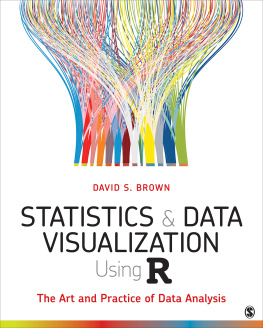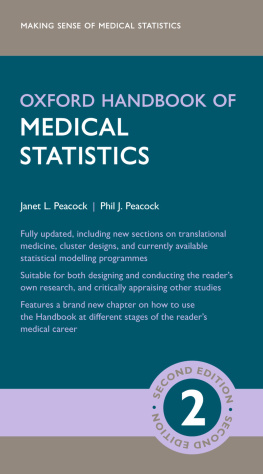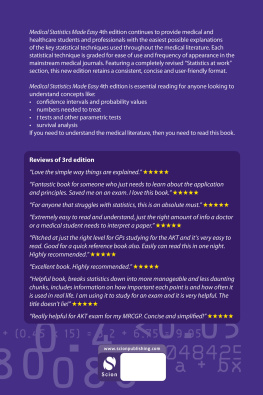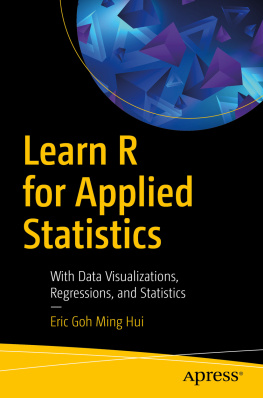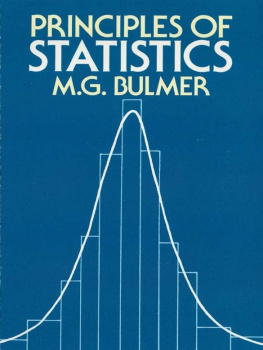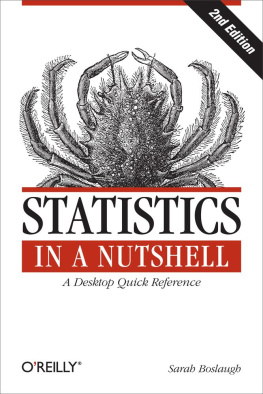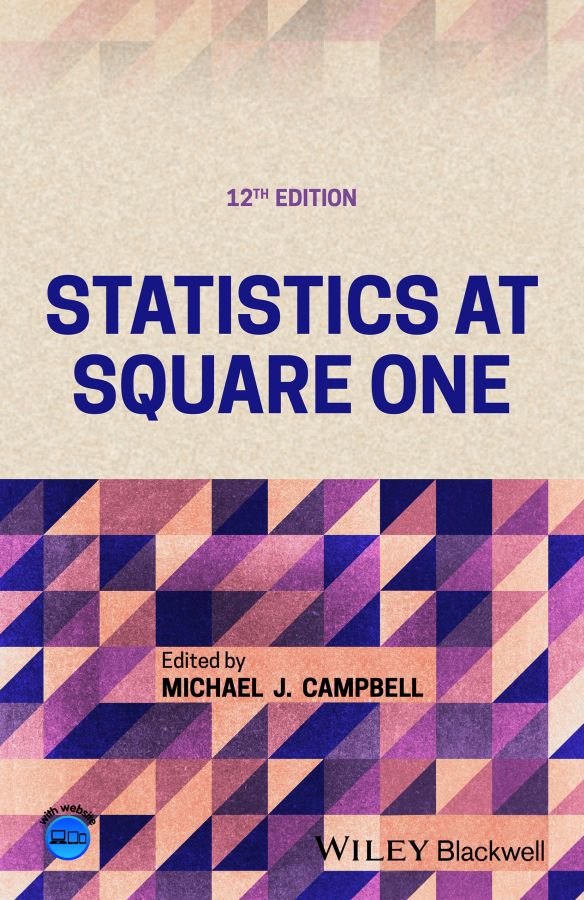
Table of Contents
List of Tables
- Chapter 2
- Chapter 3
- Chapter 4
- Chapter 5
- Chapter 6
- Chapter 7
- Chapter 8
- Chapter 9
- Chapter 10
- Chapter 11
- Chapter 12
- Chapter 13
- Chapter 14
- Appendix
List of Illustrations
- Chapter 2
- Chapter 3
- Chapter 5
- Chapter 6
- Chapter 7
- Chapter 8
- Chapter 9
- Chapter 11
- Chapter 12
- Chapter 13
- Chapter 14
Guide
Pages
Statistics at Square One
Twelfth Edition
Edited by
Michael J. Campbell
Emeritus Professor of Medical Statistics
Medical Statistics Group, School of Health and Related Research
University of Sheffield
Sheffield, UK

This edition first published 2021
2021 John Wiley & Sons Ltd
Edition History
M.J. Campbell and T.D.V. Swinscow (11e, 2009). BMJ Books was an imprint of BMJ Publishing Group Limited, used under licence by Blackwell Publishing which was acquired by John Wiley & Sons in February 2007. Previous editions: 1976, 1977, 1978, 1978, 1979, 1980, 1980, 1983, 1996, 2002
All rights reserved. No part of this publication may be reproduced, stored in a retrieval system, or transmitted, in any form or by any means, electronic, mechanical, photocopying, recording or otherwise, except as permitted by law. Advice on how to obtain permission to reuse material from this titleis available athttp://www.wiley.com/go/permissions.
The right of Michael J. Campbell to be identified as the author of this work has been asserted in accordance with law.
Registered Offices
John Wiley & Sons, Inc., 111 River Street, Hoboken, NJ 07030, USA
John Wiley & Sons Ltd, The Atrium, Southern Gate, Chichester, West Sussex, PO19 8SQ, UK
Editorial Office
9600 Garsington Road, Oxford, OX4 2DQ, UK
For details of our global editorial offices, customer services, and more information about Wiley products visit us at www.wiley.com.
Wiley also publishes its books in a variety of electronic formats and by printondemand. Some content that appears in standard print versions of this book may not be available in other formats.
Limit of Liability/Disclaimer of Warranty
The contents of this work are intended to further general scientific research, understanding, and discussion only and are not intended and should not be relied upon as recommending or promoting scientific method, diagnosis, or treatment by physicians for any particular patient. In view of ongoing research, equipment modifications, changes in governmental regulations, and the constant flow of information relating to the use of medicines, equipment, and devices, the reader is urged to review and evaluate the information provided in the package insert or instructions for each medicine, equipment, or device for, among other things, any changes in the instructions or indication of usage and for added warnings and precautions.While the publisher and authors have used their best efforts in preparing this work, they make no representations or warranties with respect to the accuracy or completeness of the contents of this work and specifically disclaim all warranties, including without limitation any implied warranties of merchantability or fitness for a particular purpose. No warranty may be created or extended by sales representatives, written sales materials or promotional statements for this work. The fact that an organization, website, or product is referred to in this work as a citation and/or potential source of further information does not mean that the publisher and authors endorse the information or services the organization, website, or product may provide or recommendations it may make. This work is sold with the understanding that the publisher is not engaged in rendering professional services. The advice and strategies contained herein may not be suitable for your situation. You should consult with a specialist where appropriate. Further, readers should be aware that websites listed in this work may have changed or disappeared between when this work was written and when it is read. Neither the publisher nor authors shall be liable for any loss of profit or any other commercial damages, including but not limited to special, incidental, consequential, or other damages.
Library of Congress CataloginginPublication Data
Names: Campbell, Michael J., 1950 author.
Title: Statistics at square one / Michael J. Campbell.
Description: Twelfth edition. | Hoboken, NJ : WileyBlackwell, 2021. | Includes bibliographical references and index.
Identifiers: LCCN 2021019285 (print) | LCCN 2021019286 (ebook) | ISBN 9781119401308 (paperback) | ISBN 9781119401421 (adobe pdf) | ISBN 9781119402343 (epub)
Subjects: MESH: Statistics as Topic Classification: LCC RA407 (print) | LCC RA407 (ebook) | NLM WA 950 | DDC 610.72/7dc23
LC record available at https://lccn.loc.gov/2021019285
LC ebook record available at https://lccn.loc.gov/2021019286
Cover Design: Wiley
Cover Image: Somatuscani/iStock/Getty Images
To Matthew, Annabel, Chloe, Robyn, Charlie, Flora and Edith.
Preface
This book is aimed at anyone who needs a basic introduction to statistics in the health sciences. It is based on many years experience teaching firstyear medical and health science students. Many of the examples are taken from primary care in the UK, which is where I worked for many years. Throughout I have tried to emphasise that medical statistics is not just a bag of tricks, and there are many synergies between its methods.
It is now over 40 years since Swinscows original edition of this book, and each edition reflected changes in the understanding of medical statistics. Perhaps the greatest change has occurred since the previous edition, which appeared 12 years ago. Despite the efforts of medical statisticians, there was a widespread misuse of P values, the cornerstone of conventional statistical inference. This led some journals to ban their use altogether. It is my view that used properly the P value is a useful concept, but this book, as in previous editions, concentrates on estimation rather than just hypothesis testing. The book tries to steer the reader away from an excessive devotion to P values, to instil a proper appreciation of their usefulness and to emphasise estimation over significance testing.
This book was revised during the COVID19 pandemic, which drew attention to the usefulness of statistics to understand public health and so there are a number of COVIDrelated examples. One area where there has been much attention is the use of diagnostic tests and the relevant chapter has been considerably updated in light of the pandemic.
There have been other important changes in the statistical arena since the 11th edition. Free statistical software has become more generally available and is easier to use, particularly R with RStudio and R commander, so I have rewritten all the examples and figures in that package. All the code is given, making replication easy. The package OpenEpi remains useful and very easy to use, so I have retained some examples applying it. Computerintensive methods such as the bootstrap are readily understood and now easily implemented, so they are included. The links between methods are described, and this is made easier with computerintensive methods, which do not require specific assumptions for different methods. The formulas and worked examples are retained because without them the computer software is just a black box. The exercises on playing with the data are also retained, since the advantage of using computers is that it is little additional effort to change the data and see the effect on the results. This kind of exercise emphasises which assumptions are important and which are less so.
Next page


